Phidget Control Panel
The Phidget Control Panel is a tool that can be used to quickly determine whether your system is able to communicate with Phidgets, and also acts as a testing and debugging tool. You can also update the firmware of attached devices, manage Phidget Dictionary entries, and remotely open and test Phidgets over the Phidget Network Service.
Windows
Once the Phidget libraries are installed using the installer, you should see the ![]() icon in the taskbar. Double click on it to bring up the Phidget Control Panel. If the icon does not appear, just find and open the Phidget Control Panel from the start menu.
icon in the taskbar. Double click on it to bring up the Phidget Control Panel. If the icon does not appear, just find and open the Phidget Control Panel from the start menu.
Phidgets Tab
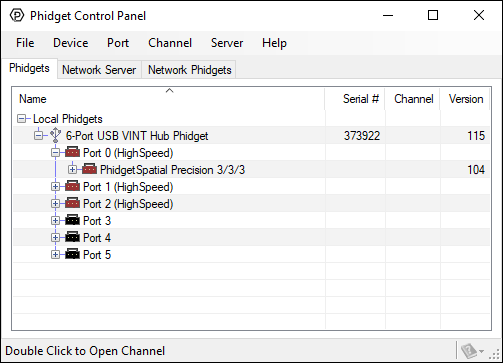
The Phidgets tab shows the list of Phidgets currently physically attached to the computer and their firmware version. It also lists the serial number that can be used in software to open a specific Phidget when more than one of the same type are connected at once. You can double click on a Phidget device in the Phidget Control Panel to open up an example program for the device.
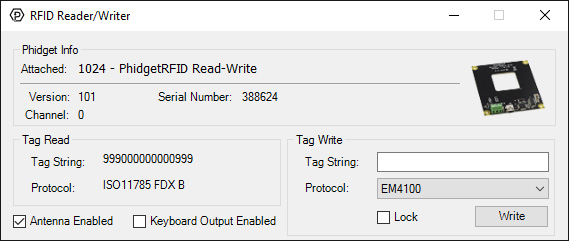
In the above screenshot, the RFID example was opened. These examples are intended for demonstration and debugging purposes. If you have not yet already, please see the Getting Started guide for your device, which is found in its user guide. It is important to keep in mind that when an example Phidget application is opened from the Phidget Control Panel or opened from any of your Phidget applications that you develop, it holds a lock on the Phidget. This prevents any other program from accessing the Phidget. Please ensure that this example application is closed (the Phidget Control Panel itself can still be running) before running your own applications.
Updating Firmware
If a Phidget shows up in red on the list in the Phidgets tab, it means the firmware is out of date. Double click on the Phidget to be given an option to apply the update. If you choose not to update, you can still use the control panel example afterwards.
Logging
The Phidget Control Panel keeps a log file of all errors, warnings, and other various information related to its operation. This information can be useful if you're having problems with your Phidgets but you're not sure what's going wrong. You can enable logging by going to File -> Options and checking the box beside Enable Logging. From the Level drop-down, you can select how detailed you want the output to be. Critical is the most basic setting, which will only log messages that are deemed to be very important. Verbose, on the other hand, will log everything, although it may be harder to find the messages that are important to you among all of the rest of the messages.
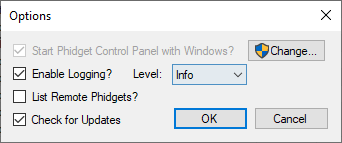
You can find the log files at C:\ProgramData\Phidgets\Logs, or you can click on Logs in the bottom right corner of the Control Panel window:

There is a separate log file for the examples and the Network Service, to make it easier to find messages that are relevant to the part you're debugging. Each message in the log file will list the type of the message, the time and date, the place in the libraries the message came from, and a description. This can be very useful for figuring out why certain parts of one of the examples or the Network Service are not working properly.
Network Service Tab
The next tab is the Network Service tab, which allows you to control Phidgets over a network.
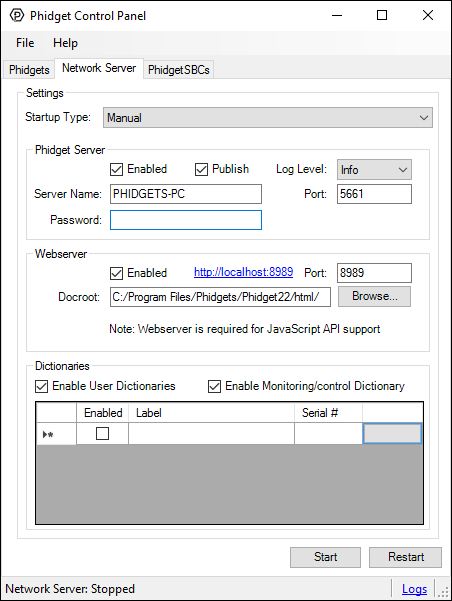
The settings are as follows:
Startup Type: Determines when the Network Service will start up. Automatic mode will cause it to start up automatically when Windows boots. Manual mode will cause it to start only when you click the Start button at the bottom of this tab. The Disabled mode means the Network Service has been disabled (normally this is set by other processes, not the Phidget Control Panel).
0000000000000000000000000000000000000000000000000000000000000000000000000000000
PhidgetSBC Tab
The last tab is the PhidgetSBC tab, which displays the complete list of any PhidgetSBCs connected to the network. This tab will be enabled if you have Bonjour installed onto your system.
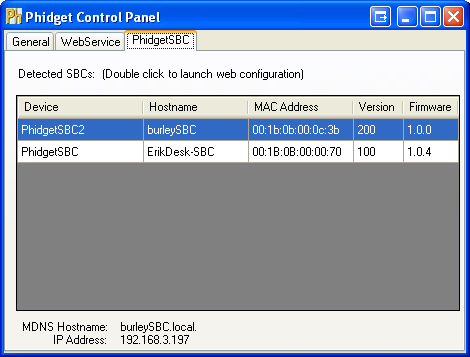
You can double click on the PhidgetSBC to bring up the PhidgetSBC Administration Console log-in page in your default browser.
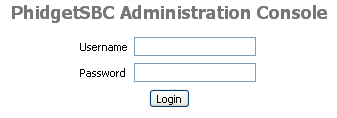
The PhidgetSBC Administration Console is where you can go to configure the PhidgetSBC. For more details, please see the PhidgetSBC section.
OS X
Once the Phidget libraries are installed using the installer, open up the System Preferences window.
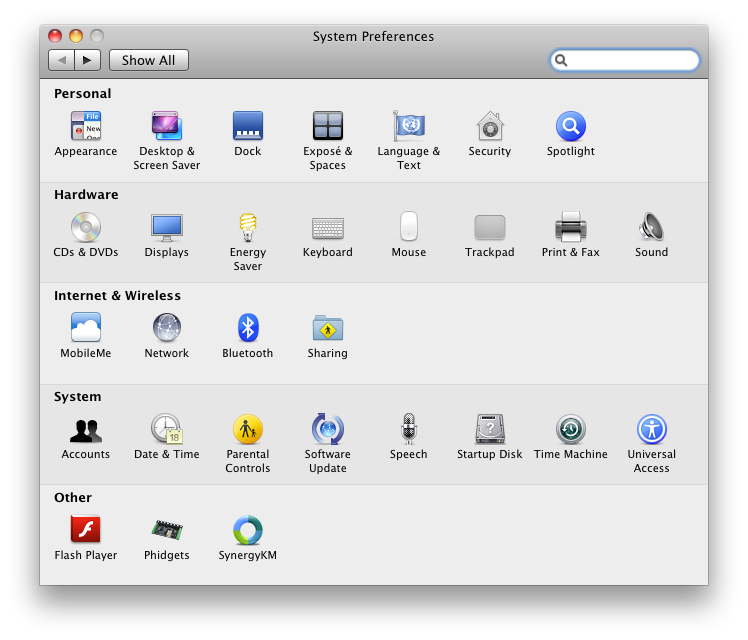
Click on the Phidgets icon in the Other section to bring up the Phidgets Preference Pane.
General Tab
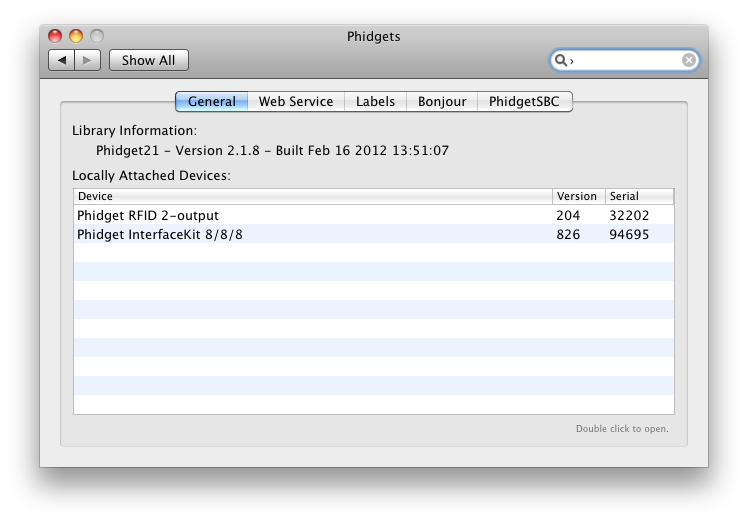
The general tab shows the list of Phidgets currently physically attached to the computer. You can also view the currently installed Phidget library version. You can double click on a Phidget device to open up an example program for the device.
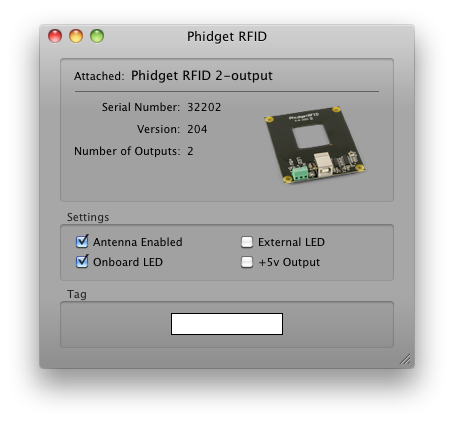
In the above screenshot, the RFID example was opened. These examples are intended for demonstration and debugging purposes. If you have not yet already, please see the Getting Started guide for your device, which may be found in its user guide.
It is important to keep in mind that when an example Phidget application is opened from the Phidget Preference Pane or opened from any of your Phidget applications that you develop, it holds a lock on the Phidget. This prevents any other program from accessing the Phidget. Please ensure that this example application is closed(the Phidget Preference Pane can still be running) when you are running your own applications.
Updating Firmware
If a Phidget shows up in red on the list in the general tab, it means the firmware is out of date. Double click on the Phidget to be given an option to apply the update. If you choose not to update, you can still use the example program afterwards.
Web Service Tab
The next tab is the Web Service tab, which allows you to control Phidgets over a network.
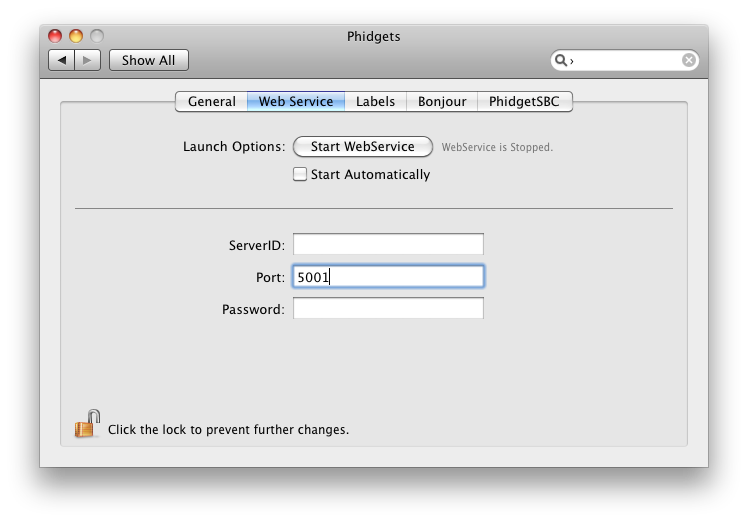
Here, you can start and stop the WebService. Details are provided in the WebService section. This screen also tells you whether the Phidget WebService is currently running.
Labels Tab
The next tab is the Labels tab. In this section, you can view the currently assigned labels of any Phidget attached to your computer. It is also possible to set the labels of Phidgets here too. You might want to set a label to a Phidget device because you can refer to it by its label as opposed to its serial number.
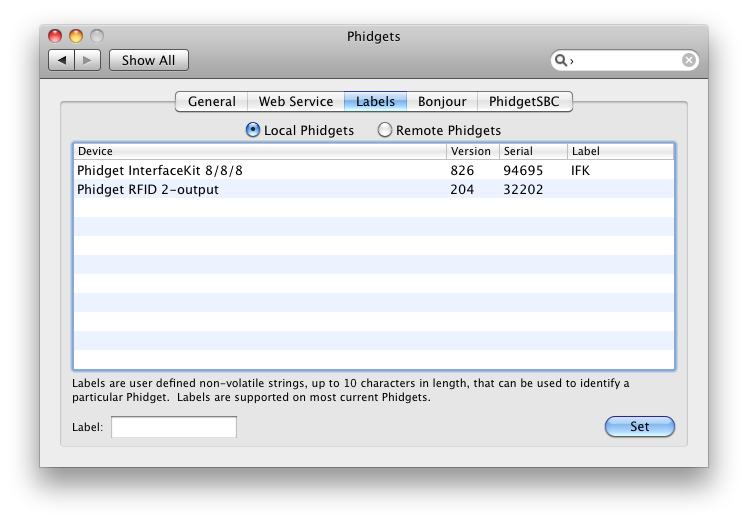
You can also view the labels of any Phidget connected through the WebService. You cannot change the label of a Phidget connected to a Windows computer, because of the way the Windows USB drivers are programmed.
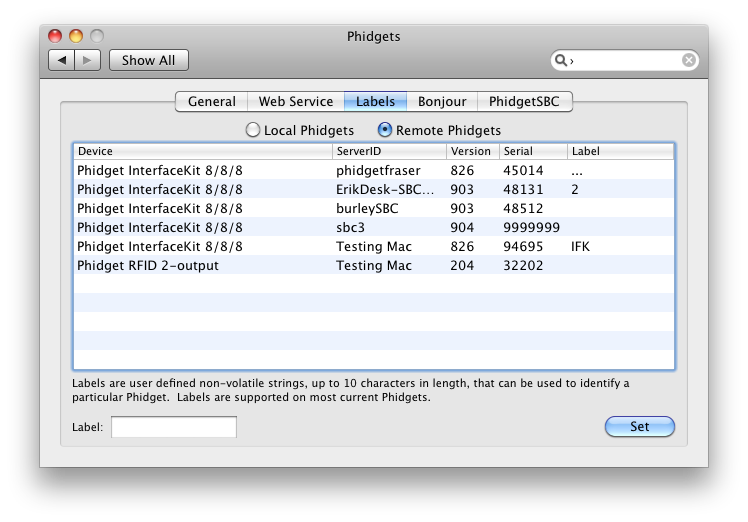
Bonjour Tab
The Bonjour tab gives a list of all currently attached Phidgets that are connected to the WebService. You can also double click on the Phidget to connect to it over the network using one or more computers, but still use the Phidget on the computer it is directly connected to.
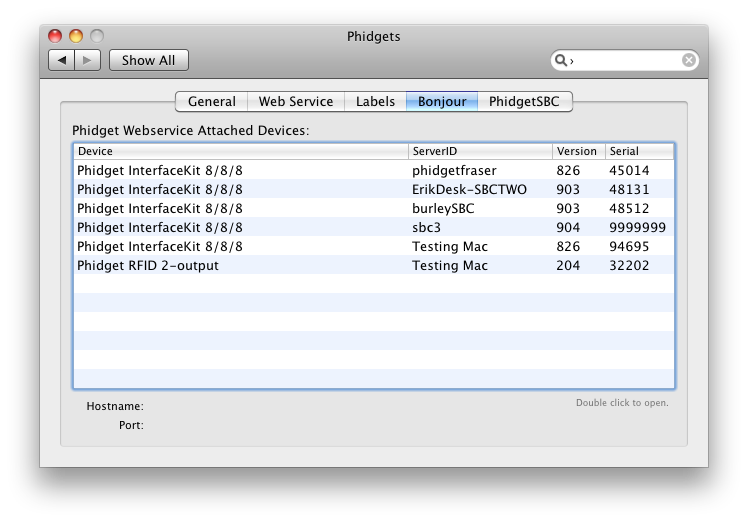
PhidgetSBC Tab
The last tab is the PhidgetSBC tab, which displays the complete list of PhidgetSBCs connected to the network.

You can double click on the PhidgetSBC to bring up the PhidgetSBC Administration Console log-in page in your default browser.

The PhidgetSBC Administration Console is where you can go to configure the PhidgetSBC. For more details, please see the PhidgetSBC section.
Linux
There is no graphical interface like the control panel or preferences pane on Linux.
See the OS - Linux page for more information on how to get started with Phidgets on Linux.
